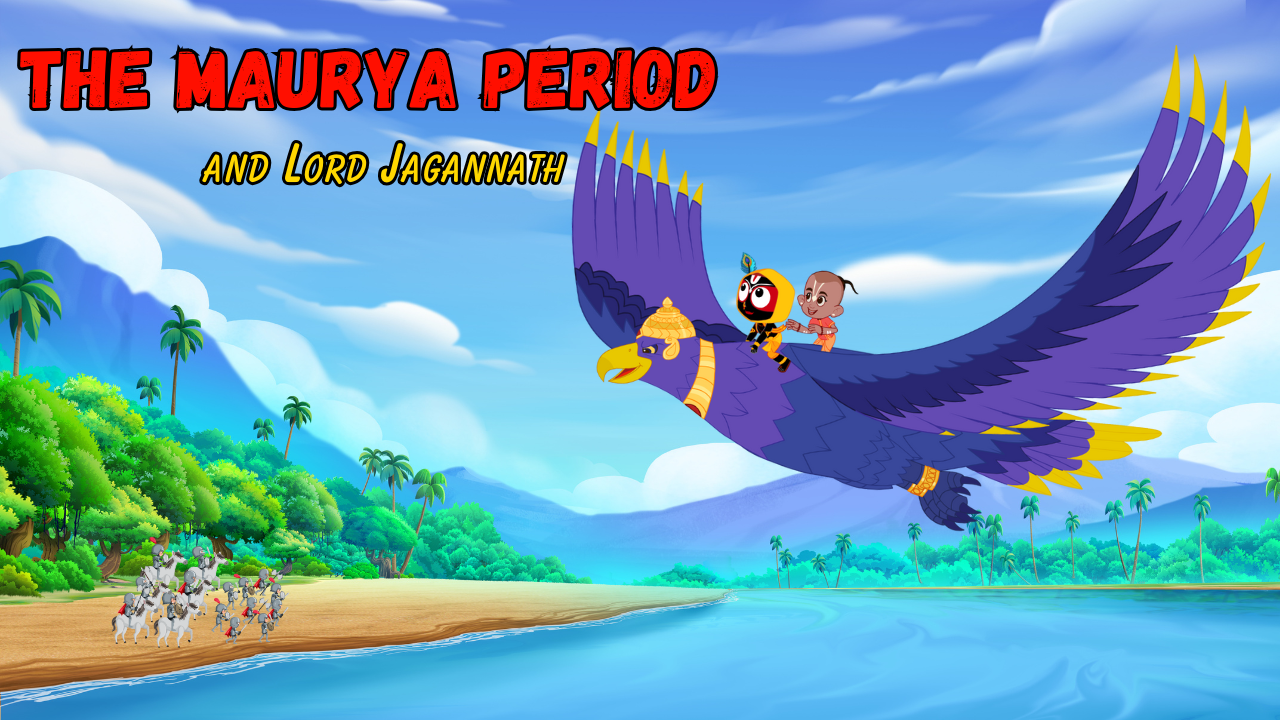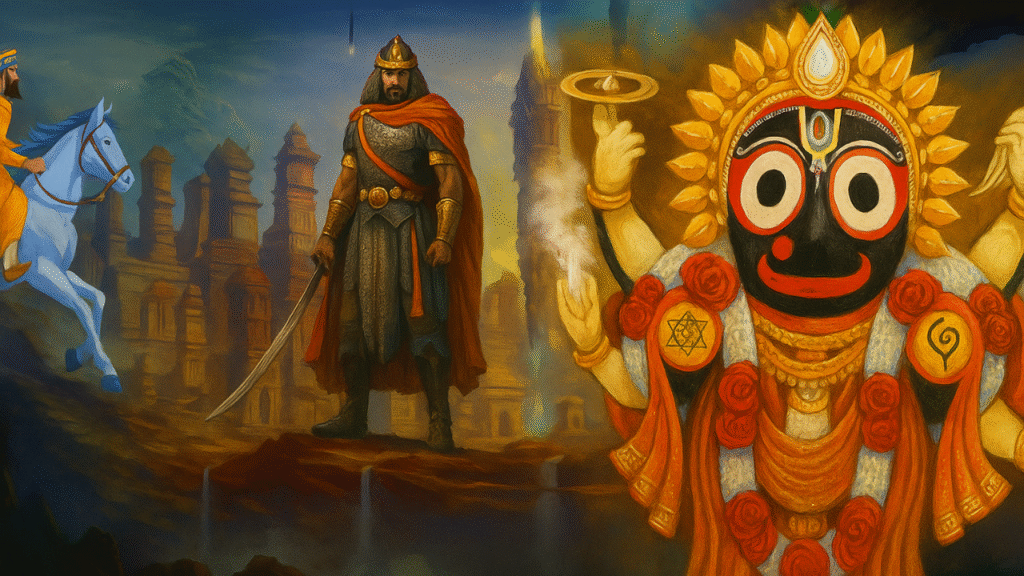
The Maurya Period and Lord Jagannath: Ancient Political & Spiritual Links
The Maurya Period and Lord Jagannath, the beloved deity of Puri, is often remembered for His grand Ratha Yatra and the message of equality and devotion that surrounds Him. But few people know that His story also connects with one of the greatest empires of ancient India—the Maurya dynasty.
The Maurya period (321–185 BCE) was not just about politics and conquests; it was also about transformation, spirituality, and cultural synthesis. The story of Emperor Ashoka, the Kalinga War, and the traditions of Odisha show how Lord Jagannath’s worship was linked with this historical era.
- The Maurya Empire – Power, Expansion, and Dharma
- The Kalinga War – A Turning Point in History
- The Maurya Period and Lord Jagannath
- Ashoka’s Dharma and Jagannath’s Universal Vision
- The Political and Spiritual Links Between Maurya and Jagannath
- The Lasting Legacy of the Maurya Period in Jagannath Culture
- A Story of Transformation and Faith
- The Eternal Bond Between Ashoka and Jagannath
The Maurya Empire – Power, Expansion, and Dharma
The Maurya dynasty, with its capital at Pataliputra (modern Patna), was India’s first great empire.
- Chandragupta Maurya established strong administration and military power.
- Bindusara, his son, extended the empire across the Deccan.
- Ashoka the Great took it to its peak, ruling almost the entire Indian subcontinent—from Afghanistan to Bengal and from Kashmir to Karnataka.
But what makes Ashoka unique is not just his military power—it is his inner transformation after the Kalinga War.
The Kalinga War – A Turning Point in History
The war of Kalinga (261 BCE) was fought between Ashoka’s Mauryan forces and the independent kingdom of Kalinga (Odisha).
- Historical accounts suggest more than one lakh soldiers and civilians died, with even more injured or displaced.
- The devastation deeply shook Ashoka’s heart.
Standing on the battlefield, he realized that conquest through violence was hollow. From that moment, Ashoka turned away from warfare and became a messenger of Dharma, peace, and non-violence.
This transformation happened in Odisha—the very land where Lord Jagannath’s worship was taking shape.
The Maurya Period and Lord Jagannath
Even before the grand temple of Puri was built, Odisha’s tribal communities worshipped wooden idols, which represented the Darubrahma (Divine in Wood).
- These early deities were worshipped under trees and in open spaces.
- The rituals were simple but filled with faith and devotion.
- They symbolized the idea that God is not distant, but lives in the simplest forms of nature.
Ashoka, who respected and supported multiple traditions after the Kalinga War, allowed such indigenous practices to flourish. Over time, these traditions blended with Vedic rituals and Buddhist influences, shaping the Jagannath tradition.

Ashoka’s Dharma and Jagannath’s Universal Vision
Ashoka spread his message of Dharma through rock and pillar edicts across India, many of which still exist in Odisha. These inscriptions highlight values such as:
- Ahimsa (Non-violence) – avoid killing and harming.
- Karuna (Compassion) – show kindness to all living beings.
- Samata (Equality) – treat all religions with respect.
- Seva (Service) – live for the welfare of others.
These same values are mirrored in Lord Jagannath’s tradition. At the Ratha Yatra, no distinction is made between rich or poor, king or commoner. Everyone has the same right to pull the Lord’s chariot. This inclusiveness reflects both Ashoka’s Dharma and Jagannath’s divine vision.
The Political and Spiritual Links Between Maurya and Jagannath
The Maurya connection to Jagannath can be seen in two ways:
- Political Link – Ashoka’s conquest of Kalinga brought Odisha into the Mauryan Empire, connecting its culture with the larger Indian subcontinent.
- Spiritual Link – Ashoka’s transformation after the war aligned closely with Jagannath’s message of compassion and equality, allowing the worship to spread and flourish.
Thus, the Maurya period was not only about politics but also about the spiritual soil that nurtured Jagannath’s growing tradition.
The Lasting Legacy of the Maurya Period in Jagannath Culture
The influence of the Maurya era continues to be felt in the culture of Jagannath worship:
- Preservation of Tribal Faiths – The wooden deities survived and became central to Jagannath.
- Fusion of Traditions – Buddhism, tribal worship, and Vedic rituals blended into the Jagannath cult, creating a truly universal form of worship.
- Equality and Oneness – Just as Ashoka wanted unity in diversity, Jagannath represents inclusiveness for all communities.
- Compassion as Strength – The lesson Ashoka learned at Kalinga—true power is compassion—is at the heart of Jagannath’s spiritual message.
A Story of Transformation and Faith
Imagine the scene: Ashoka stands on the battlefield of Kalinga, surrounded by silence after the storm of war. The cries of the wounded fill the air. His heart is heavy with guilt. At the same time, in the forests of Odisha, tribal people worship their simple wooden deity—the Lord who accepts all, beyond caste or creed.
This is the turning point where politics meets spirituality, where conquest bows before compassion. From this soil grew the universal tradition of Lord Jagannath, who today unites millions with love and equality.
The Eternal Bond Between Ashoka and Jagannath
The story of the Maurya period and Lord Jagannath is not just history—it is a timeless reminder that the greatest power lies in compassion, equality, and unity.
Ashoka came to Odisha as a conqueror, but he left transformed into a messenger of Dharma. And in the same land, Lord Jagannath emerged as a universal deity, worshipped by all without barriers.


Leave a reply here
Your email address will not be published. Required fields are marked *